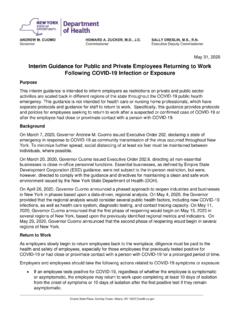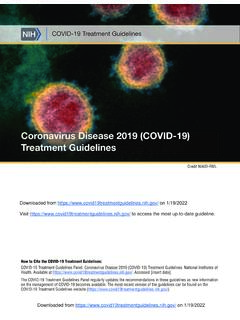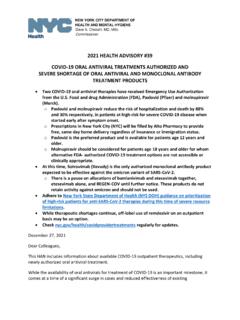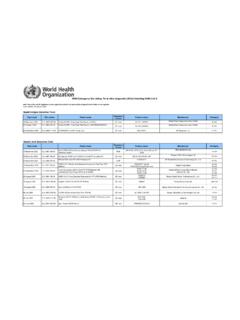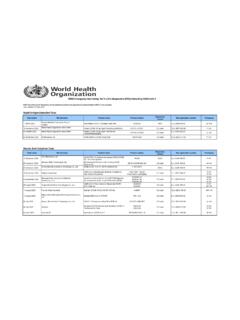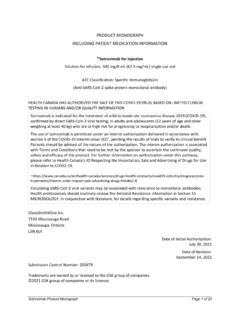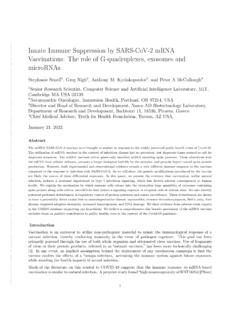Transcription of Prioritization of Anti-SARS-CoV-2 Monoclonal Antibodies ...
1 Prioritization of Anti-SARS-CoV-2 Monoclonal Antibodies and Oral Antivirals for the Treatment of COVID-19 During Times of Resource Limitations Introduction In times of limited supplies of Monoclonal Antibodies (mAbs) and oral antivirals (OAVs), providers should prioritize patients eligible for treatment based on their level of risk for progressing to severe COVID-19. In addition, the most efficacious products should be prioritized for patients with the highest risk for hospitalization and According to the NIH COVID-19 Treatment Guidelines, triage and Prioritization should only be implemented when logistical or supply constraints make it impossible to offer the therapy to all eligible patients. During periods of limited resources, the Panel suggests: Prioritizing the treatment of COVID-19 and Prioritizing Anti-SARS-CoV-2 mAbs and OAVs for unvaccinated or incompletely vaccinated individuals and vaccinated individuals who are not expected to mount an adequate immune response ( , individuals with moderate to severe immunocompromise or individuals aged 65 years).
2 As reminder, Monoclonal Antibodies and oral therapeutics are not a substitute for vaccination in individuals for whom vaccination is recommended. Providers should continue recommending COVID-19 vaccination as the best strategy to prevent COVID-19 severe disease, hospitalizations, and deaths. Patients who have moderate to severe immune compromise (due to a medical condition or receipt of immunosuppressive medications or treatments) or are unable to receive COVID-19 vaccines due to a history of a severe adverse reaction to a COVID-19 vaccine should be considered for pre-exposure prophylaxis with a long-acting Monoclonal antibody (Evusheld). How to use this framework Each patient should be assigned to a group within Tier 1 and then prioritized within the respective group.
3 Patients assigned to 1A should be considered the highest priority, with 1B being the next highest priority and so on. The recommended therapy section notes which groups should receive therapy without exception and which groups may need to be put on a wait list if supplies of a given therapeutic are limited. 1 In clinical trials, Paxlovid demonstrated an 88% reduction in hospitalizations and death in high-risk unvaccinated adults vs. 85% for Sotrovimab vs. 30% for Molnupiravir Tier 1: Prioritization Groups for the Treatment of COVID-19 For treatment, patients must have mild to moderate symptoms, test positive for SARS-CoV-2, and be within 10 days of symptom onset for mAbs or within 5 days for oral antivirals Risk Groups Recommended Therapy/Approach Notes on Prioritization 1A.
4 Any age with moderate to severe immunocompromise regardless of vaccine status or Age 65 and older and not fully vaccinated with at least one risk factor for severe illness or Age 65 or older that is a resident of a long-term care facility environment Refer for Monoclonal antibody therapy (mAb) or prescribe Paxlovid, ideally within 24 hours of positive test Consider molnupiravir if the options above are not available If needed, prioritize patients based on Age Number of risk factors 1B. Under 65 years of age and not fully vaccinated with two or more risk factors for severe illness or over 65 and not fully vaccinated (no risk factors) Consider mAbs or OAVs if supplies allow If needed, prioritize patients based on Age Number of risk factors 1C. Under 65 years of age and not fully vaccinated with at least one risk factor for severe illness Consider mAbs or OAVs if supplies allow If needed, prioritize patients based on Age 1D.
5 Over age 65 and fully vaccinated with at least one risk factor for severe illness Consider mAbs or OAVs if supplies allow If needed, prioritize patients based on Age Number of risk factors Receipt of booster Time since last vaccination 1E. Under 65 years of age and fully vaccinated with at least one risk factor for severe illness or Age 65 and older and fully vaccinated with no other risk factors Consider mAbs or OAVs if supplies allow If needed, prioritize patients based on Age Number of risk factors Receipt of booster Time since last vaccination Notes We recommend using BMI 30 as a cutoff for weight-based risk factor The risk of severe disease increases with the number of comorbidities, even among fully vaccinated individuals2 Non-white race or Hispanic/Latino ethnicity should be considered a risk factor.
6 As longstanding systemic health and social inequities have contributed to an increased risk of severe illness and death from COVID-19 See CDC guidance for further information on specific medical conditions and associated risk Fully vaccinated is currently defined as having received two doses of an mRNA vaccine, or a single dose of the Johnson & Johnson vaccine 2 Bierle et al, mAb Treatment of Breakthrough COVID-19 in Fully Vaccinated Individuals with High-Risk Comorbidities. JID 2021







